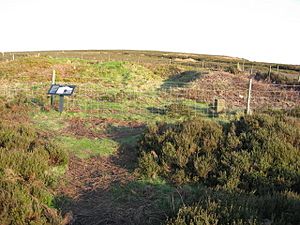Hob Hurst's House facts for kids
Hob Hurst's House is a special ancient burial mound located on Beeley Moor near Bakewell in Derbyshire, England. It was built during the Bronze Age, a time long ago when people used bronze tools. Most burial mounds from this period are round, but Hob Hurst's House is unique because it's shaped like a rectangle! It was originally made with 13 large stones, but today, only five of them are still standing.
This ancient site sits on the highest part of Beeley Moor. The main mound is about 11 yards (or 10 meters) across and 4 feet (about 1.2 meters) high. It also has a ditch and an outer bank that stretches about 22 yards (or 20 meters) wide.
Contents
What is Hob Hurst's House?
Many ancient mounds can be found on these moors. Most of them are burial sites from the late Neolithic period (New Stone Age) and early Bronze Age. Families from long ago built these mounds in their fields and pastures. They used them to bury the bones of their ancestors, creating visible symbols that showed where their community belonged. Hob Hurst's House stands out because of its unusual square shape, its surrounding ditch, and its outer bank.
Why is it Called Hob Hurst's House?
The interesting name, Hob Hurst's House, comes from an old story. It refers to a mythical creature, a friendly but mischievous hobgoblin, who was said to live in the nearby woods.
Protecting Ancient History
Hob Hurst's House was one of the very first ancient sites in Britain to be officially protected by the government. This happened in 1882, thanks to a law called the Ancient Monuments Protection Act. Around that time, stone markers with the letters "VR" were placed around the site. "VR" stands for Victoria Regina, which means Queen Victoria, who was the ruler at the time.
Discoveries from the Past
In 1853, a famous archaeologist named Thomas Bateman, sometimes called the "Barrow Knight," excavated the mound. During his dig, he found a grave lined with stones. Inside, he discovered some human bones that had been burned, along with some lead ore. These findings help us understand how people lived and buried their dead thousands of years ago.
Today, Hob Hurst's House is looked after by English Heritage, an organization that cares for historic places. It is also recognized as a Scheduled Ancient Monument, which means it's a very important historical site that is legally protected.
Exploring the Area
If you enjoy walking, the Peak District Boundary Walk passes right by Hob Hurst's House. This walking path goes alongside Gibbet Moor, past the ancient mound, and continues on to the village of Beeley. It's a great way to see this historical site and enjoy the beautiful moorland scenery.


